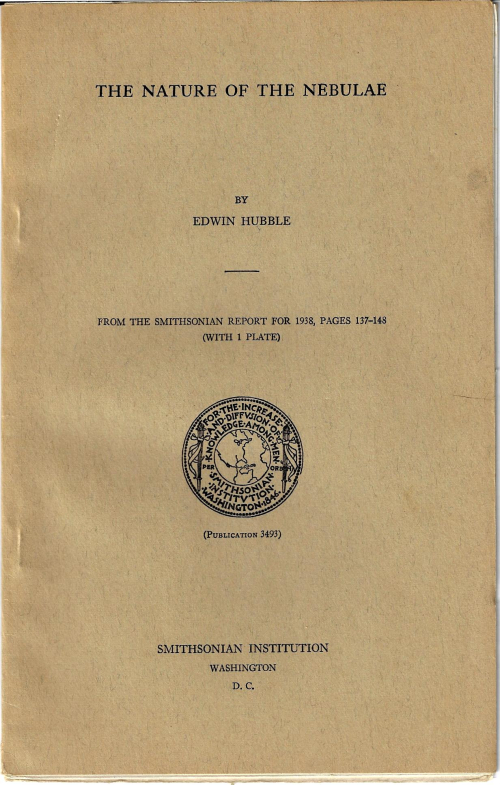 Edwin Hubble, "The Nature of the Nebulae", offprint from the Smithsonian Report for 1938, pages 137-148, with one plate), publication 3493. Published by the Smithsonian Institution in Washington, D.C., 1939. 24cm.
Edwin Hubble, "The Nature of the Nebulae", offprint from the Smithsonian Report for 1938, pages 137-148, with one plate), publication 3493. Published by the Smithsonian Institution in Washington, D.C., 1939. 24cm.
Original wrappers. Very fine condition, and save for a faded 5mm blemish on upper front cover right corner, in nearly new condition. $95
“Hubble was the founder of modern extragalactic astronomy and the first to provide observational evidence for the expansion of the universe Hubble was the first to introduce a significant classification system for galaxies He presented this at the meeting of the International Astronomical Union at Cambridge, England, in 1925 and it was published the next year in the Astrophysical Journal... The classification was essentially empirical and independent of any assumptions concerning the evolution of galaxies. ..”
“Despite the advance in knowledge in the last forty years, Hubble’s claim to have introduced order into the apparent confusion of nebular forms and to have shown that galaxies are closely related members of a singly family stands. It must be regarded as one of his most significant achievements.
By 1929 Hubble had obtained distances for eighteen isolated galaxies and for four members of the Virgo cluster. In that year he used this somewhat restricted body of data to make the most remarkable of all his discoveries and the one that made his name famous far beyond the ranks of professional astronomers.”
Hubble's (and Humason's ) observations on the greater distances of fainter galaxies...”Hubble’s law was extended to a distance of over 100 million light-years, the straight-line relationship between velocity and distance being maintained. This result has come to be generally regarded as the outstanding discovery in twentieth-century astronomy. It made as great a change in man’s conception of the universe as the Copernican revolution 400 years before. For, instead of an overall static picture of the cosmos, it seemed that the universe must be regarded as expanding, the rate of the mutual recession of its parts increasing with their relative distance....”--DSB




Comments